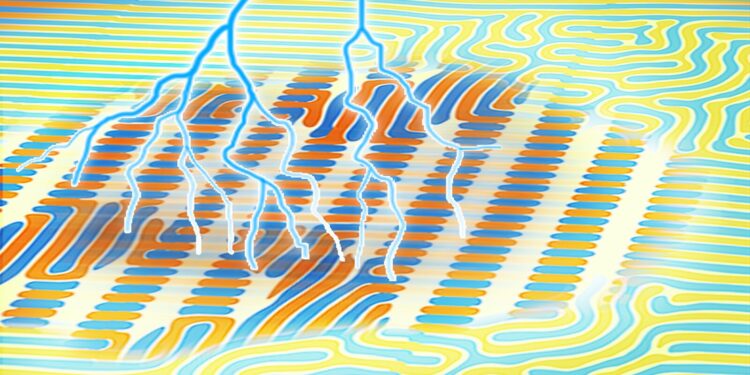Artistic rendering depicting light pulses producing adaptive transformations in nanodomain structures applicable to neuromorphic computing. Credit: Argonne National Laboratory / Haidan Wen
The researchers revealed an adaptive response with a ferroelectric device, which responds to light pulses in a way that resembles the plasticity of neural networks. This behavior could find application in energy-efficient microelectronics.
“Today’s supercomputers and data centers require several megawatts of power,” said Haidan Wen, a physicist at the U.S. Department of Energy’s (DOE) Argonne National Laboratory. “One of the challenges is finding materials for more energy-efficient microelectronics. One promising candidate is a ferroelectric material that can be used for artificial neural networks as a component of energy-efficient microelectronics.”
Ferroelectric materials can be found in different types of information processing devices, such as computer memories, transistors, sensors and actuators. Argonne researchers report surprising adaptive behavior in a ferroelectric material that can evolve step by step to the desired goal, depending on the number of photons from light pulses striking the material. Alongside the Argonne researchers were scientists from Rice University, Pennsylvania State University and DOE’s Lawrence Berkeley National Laboratory.
The article is published in the journal Advanced materials.
This team’s hardware is loaded with networked islands or domains as distinct as oil in water. These domains measure nanometers (billionths of a meter) and can rearrange themselves in response to pulses of light. This adaptive behavior could be used in the energy-efficient movement of information in microelectronics.
The team’s ferroelectric sample is structured as a sandwich of alternating layers of lead and strontium titanate. Prepared by Rice University collaborators, this seven-layer sandwich is 1,000 times thinner than a piece of paper. Previously, the team had shone a single intense pulse of light onto a sample and created uniform ordered structures on the nanoscale.
“This time, we hit the sample with many weak pulses of light, each of which lasts a quadrillionth of a second,” Wen said. “As a result, a family of domain structures, rather than a single structure, was created and imaged, based on the optical dosage.”
To visualize the responses at the nanoscale, the team used the Nanoprobe (26-ID beamline) operated by the Center for Nanoscale Materials and the Advanced Photon Source (APS). Both are DOE Office of Science user facilities at Argonne. With the Nanoprobe, an X-ray beam several tens of nanometers in diameter scanned the sample as it was exposed to a barrage of ultrafast light pulses.
The resulting images revealed that networked nanodomains were created, erased and reconfigured using the light pulses. The regions and boundaries of these domains have evolved and reorganized over lengths from 10 nanometers, about 10,000 times smaller than a human hair, to 10 micrometers, about the size of a droplet of cloud. The final product depends on the number of light pulses used to stimulate the sample.
“By coupling an ultrafast laser to the Nanoprobe beamline, we can initiate and control changes in networked nanodomains using light pulses without requiring much energy,” said X-ray microscopy scientist Martin Holt. electronics and group leader.
The sample begins with a cobweb-like arrangement of nanodomains and, due to the disruption created by the light pulses, the web breaks down and forms entirely new configurations that function in service of a desired end by analogy with an adaptive network.
“We discovered entirely new arrangements of these nanodomains,” said Stephan Hruszkewycz, an Argonne physicist and group leader. “The door is now wide open to many more discoveries. In the future, we will be able to test different light stimulation regimes and observe even more unknown nanodomains and networks.”
The ability to visualize nanoscale changes over time will be greatly improved with the recent APS upgrade, promising X-ray beams up to 500 times brighter.
With this groundbreaking discovery of time-dependent changes in networked nanodomains, developers are well on their way to building adaptive networks for information storage and processing. This advancement promises to create more energy-efficient computing systems.
In addition to Wen, Holt and Hruszkewycz, the study’s authors include Marc Zajac, Tao Zhou, Tiannan Yang, Sujit Das, Yue Cao, Burak Guzelturk, Vladimir Stoica, Mathew Cherukara, John Freeland, Venkatraman Gopalan, Ramamoorthy Ramesh, Lane Martin and Long-Qing Chen.
More information:
Marc Zajac et al, Optical control of adaptive domain networks at the nanoscale, Advanced materials (2024). DOI: 10.1002/adma.202405294
Provided by Argonne National Laboratory
Quote: Adaptive ferroelectric materials show promise for energy-efficient supercomputing (October 16, 2024) retrieved October 16, 2024 from
This document is subject to copyright. Except for fair use for private study or research purposes, no part may be reproduced without written permission. The content is provided for informational purposes only.



